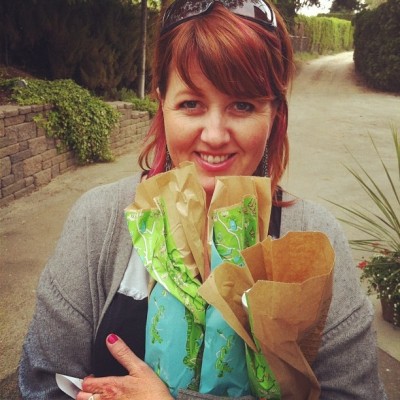Small Potatoes: Fitting big dreams for local eating into a teeny tiny space
May 23, 2012
This is the first of two blogs contributed by Suvi Tiegen, a Social Worker; Adoption Specialist and a member of the Better Together community with a passion for eating locally and consciously. In this guest contribution, Suvi explains how she hasn’t let her passion for “living off the land” become crushed by the confines of her small apartment in the city. Enjoy this wealth of advice for apartment dwellers on how to maintain rural ideals in an urban lifestyle, including everything from preserving food, to patio gardening to joining a meat coop. Enjoy!

Small Potatoes: Fitting big dreams for local eating into a teeny tiny space
Six years ago, I moved to Vancouver from Lethbridge and, in the process, traded in my 1800 square foot home on a corner lot for 650 square feet of big city living in East Vancouver. Just my luck that this move should coincide with an increased conviction on my part to live and eat more locally. Many books, ideas, and failed patio gardens later, I’ve stumbled upon some sure-fire ways to fit this philosophy into my life and my apartment. Here are some of the tips I’ve gathered up:
1. Invest in a freezer, even if it’s small. This may sound counter-intuitive when we’re talking small spaces, but it will sure make life a lot easier when you’re thinking local. In fact, I would say that investing in a freezer is a key component to sustaining a philosophy of local consumption. Even if you live in a small space, you should be able to squeeze one into your apartment. Take me for example. I bought a small used freezer on craigslist and have managed to create a space for it in my bedroom, without creating too much of an eyesore. Sure, there may be some banter amongst my peers about the kinds of people who would have a deep freeze in their bedroom (a serial killer, for example). But if you can get past the ridicule, find a corner and shove a freezer into it!
2. Know your food seasons. I’m a huge fan of buying everything in its prime; almost all of the fruit I consume throughout the year is purchased and preserved in its season. Berry season, for example, is just around the corner, and it’s a good idea to get prepared. Many local farms will post updates on their websites, letting you know when the berries are ready and when’s the best time to buy. And when I buy, I buy big. By mid-July, I’ve eaten my fill of fresh berries and filled my freezer with more for the winter. As you begin to eat in season, you’ll realize that you’ve been short-changing yourself with those imported strawberries (newsflash: they aren’t supposed to be white inside!) and you’ll find the value of enjoying something truly awesome for a short period of time and then letting it go. You’ll move on to the next season knowing you enjoyed the best from the last season, and that it will come around again. Although I go straight to the farms for my berries, your local farmer’s market is a great resource for knowing what’s in season. They usually have a card available at the information table, so stop by and pick one up, or check out the BC Farmers Market Association website.
It’s easy to get your kids in on the action as well. One idea I love is to make some fruit and vegetable fridge magnets or pictures and rotate them season-by-season, to help your kids identify the kinds of fruit they should be looking for.
And berry picking is always a great family activity. Just the other day my mom and I were reminiscing about the many days spent at my grandparents farm in the raspberry patch. We ate our way through pounds of berries and with six kids, my mom still got her quota for the freezer. (Caveat: I’m pretty sure the berry producers frown on the free consumption of their berries like we did at grandma’s place!). Let your kids pick some berries and purchase the rest by the case.
3. Join or start a meat co-op. When I lived in Alberta, it wasn’t uncommon to buy a side of beef, a pig, or a case of chickens from someone you knew. However, doing so necessitates a few things – like knowing someone with a cow, for instance, and the ability to store that much meat. Not a challenge when you’ve got a chest freezer in your four bedroom house, but more of an issue when you’ve shoved a teeny freezer under your jewelery rack in your bedroom. Many of us can miss out on some of the deals local farmers might have for larger purchases. Solution: grab a few like-minded friends and buy in bulk from local producers.
(Side note: For heaven’s sake – learn what to do with a whole chicken! If you can learn how to cut up a whole chicken, use all the pieces, cook the leftovers and make your own broth, you’ll save a bunch of money buying whole chickens rather than pieces, and never need to buy sodium-filled broth again. The freezer comes in handy here, too. I freeze the bones until I have the time and inclination to make a batch o’ broth, and then I freeze that in mason jars, too.)
Great advice Suvi! Watch for part-two in this series, coming next week. Suvi will talk about the importance of farm field trips, preserving and growing food yourself (sans space). Have some tips of your own to share with us? Join the conversation here!

















(2) Comments
Krista
May 29, 2012 at 11:59 AM
Making chicken stock (or any kind of stock actually) is easy if you invest in a crock pot. We don’t have a deep freeze (I never thought of squeezing one into our place but it does seem like a good idea…) in our place so we need the bones to rotate out of the fridge freezer on a frequent basis. A crockpot lets you throw all the stuff in, put it on low for 8 hours and when you get home just put the stock in freezer bags, jars or use it. Doesn’t take a lot of time to do and it’s FAR superior to what you buy in the store (and less expensive).
Look forward to the next part of your blog!
Suvi
May 29, 2012 at 1:38 PM
Wow! Excellent tip, Krista. This will make my life so much more convenient because I’ve been sitting at home monitoring broth all day! Haha! You’ve just given me the gift of time - gonna throw my next batch on while I’m at work. Genius!!